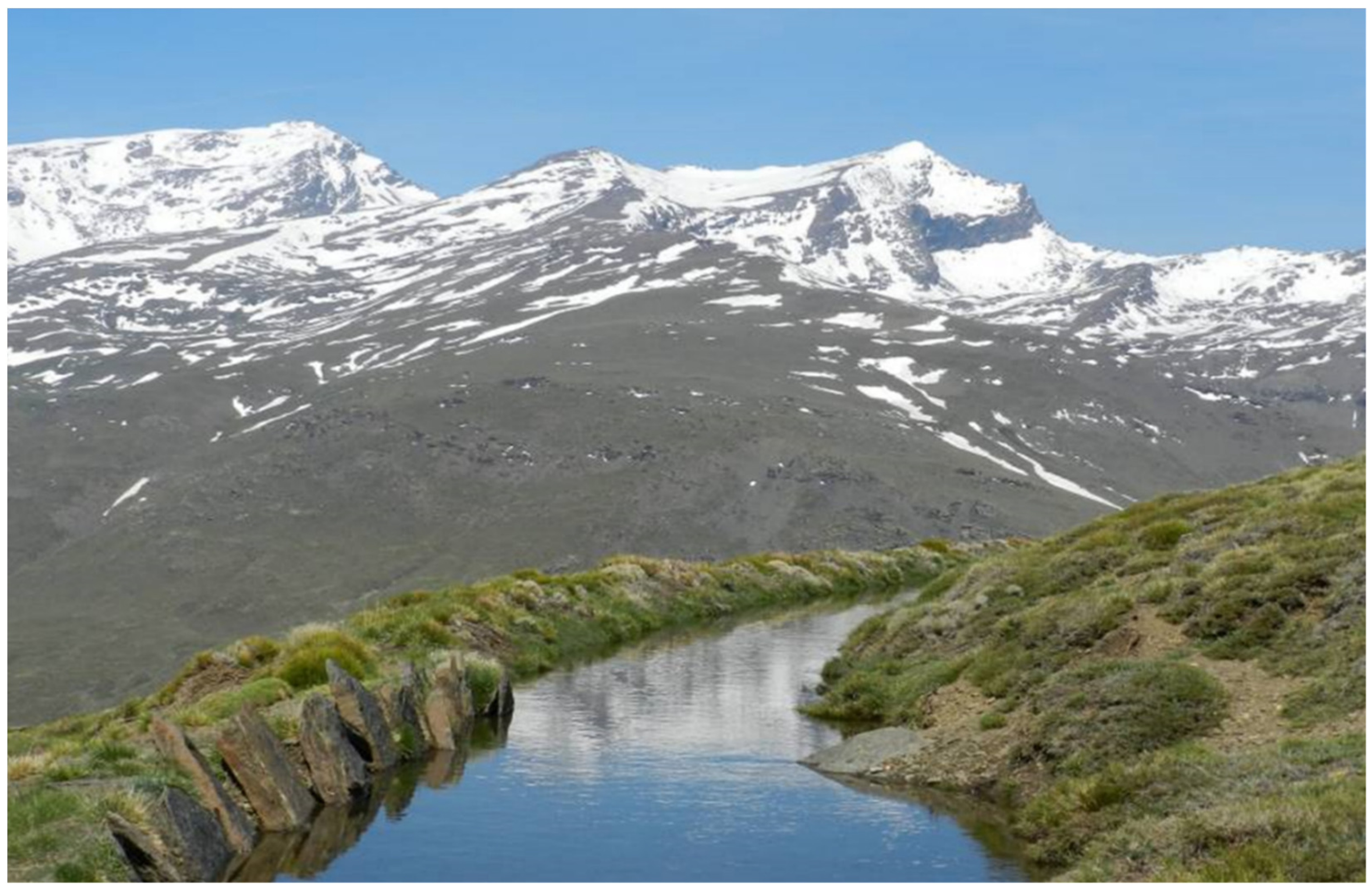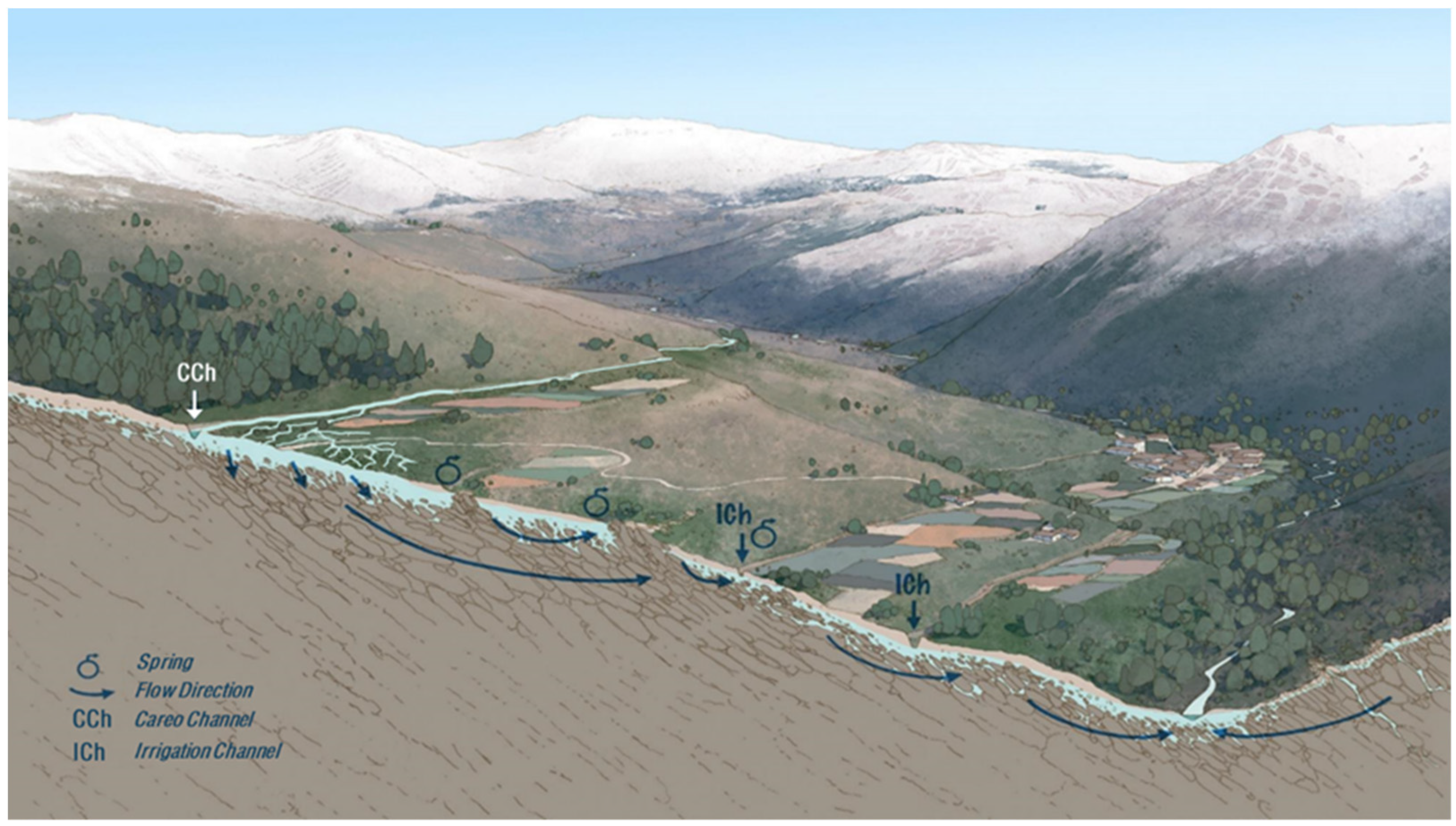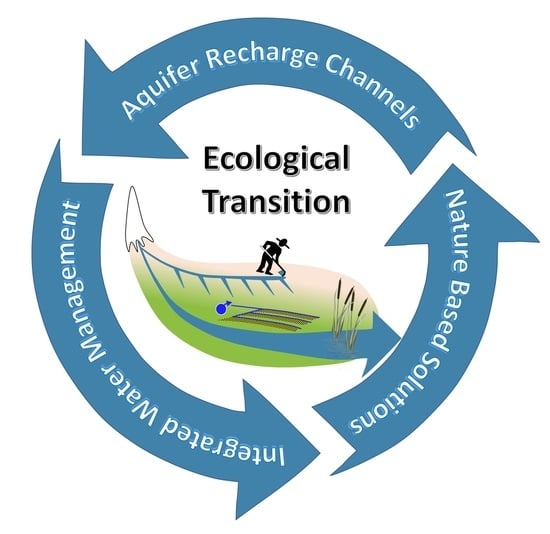The Recharge Channels of the Sierra Nevada Range (Spain) and the Peruvian Andes as Ancient Nature-Based Solutions for the Ecological Transition
Abstract
1. Introduction
2. Recharge Channels in Mountain Zones as NbS-IWRM for the Ecological Transition
- (i)
- delaying the transit time of water through the ground to maintain the flow of rivers and springs at lower altitudes during the summers, when radiation and temperature favor crop growth, but rainfall is scarce, and the demand for drinking water increases,
- (ii)
- watering the vegetation on the mountain slopes (Figure 2), favoring the growth of pastures, and enhancing biodiversity, and
- (iii)
- improving water quality by diluting the salinity of evapo-concentrated groundwater and filtering runoff water. Therefore, the spatio-temporal regulation of water resources for different uses and the associated ecosystem services qualifies this WS&H “green infrastructure” as an NbS-IWRM [43].
3. Science to Understand Better Recharge Channels
4. Current Challenges
5. Conclusions
Author Contributions
Funding
Data Availability Statement
Acknowledgments
Conflicts of Interest
References
- United Nations. Transforming Our World: The 2030 Agenda for Sustainable Development(A/RES/70/1); UN General Assembly: New York, NY, USA, 2015; Available online: https://sdgs.un.org/2030agenda (accessed on 30 August 2022).
- Belda, E.T. El Agua en el Contexto de la Transición Ecológica. Entrevista a Pedro Arrojo Agudo [Water in the Context of the Ecological Transition. Interview with Pedro Arrojo Agudo]. Relac. Int. 2020, 45, 377–383. Available online: https://revistas.uam.es/relacionesinternacionales/article/view/12900 (accessed on 30 August 2022).
- United Nations. Nature-Based Solutions for Water 2018: The United Nations World Water Development Report 2018; UN-Water United Nations World Water Assessment Programme: Geneva, Switzerland, 2018; Available online: https://wedocs.unep.org/20.500.11822/32857 (accessed on 30 August 2022).
- Martín-Civantos, J.M. Poblamiento y Territorio Medieval en el Zenete, Granada [Medieval Settlement and Territory in Zenete, Granada]; Editorial Universidad de Granada: Granada, Spain, 2007; p. 773. [Google Scholar]
- Martín Civantos, J.M. Las Aguas del Río Alhama de Guadix y el Sistema de Careos de Sierra Nevada (Granada) en Época Medieval [The Waters of the River Alhama de Guadix and the System of Careos de Sierra Nevada (Granada) in medieval times]. In El Paisaje y su Dimensión Arqueológica. Estudios Sobre el Sur de la Península Ibérica en la Edad Media; Alhulia: Granada, Spain, 2010; pp. 79–111. Available online: http://opac.regesta-imperii.de/id/2433415 (accessed on 31 August 2022).
- Martos-Rosillo, S.; González-Ramón, A.; Marín-Lechado, C.; Cabrera, J.A.; Guardiola-Albert, C.; Jodar, J.; Navarrete, E.; Ruiz-Constán, A.; Moral, F.; Pedrera, A.; et al. Las acequias de careo de Sierra Nevada (Sur de España), un sistema de recarga ancestral en acuíferos de alta montaña [The irrigation channels of the Sierra Nevada (Southern Spain), an ancestral recharge system in high mountain aquifers]. In Manejo de la Recarga de Acuíferos; Escolero, O., Gutiérrez, C., Mendoza, E., Eds.; Instituto Mexicano de Tecnología del Agua (IMTA): Jiutepec, Mexico, 2017; pp. 527–563. Available online: https://www.imta.gob.mx/biblioteca/libros_html/manejo-recarga-acuiferos-ehl.pdf (accessed on 30 August 2022)Available online: .
- Ochoa-Tocachi, B.F.; Bardales, J.D.; Antiporta, J.; Pérez, K.; Acosta, L.; Mao, F.; Zulkafli, Z.; Gil-Ríos, J.; Angulo, O.; Grainger, S.; et al. Potential contributions of pre-Inca infiltration infrastructure to Andean water security. Nat. Sustain. 2019, 2, 584–593. [Google Scholar] [CrossRef]
- Martos-Rosillo, S.; Durán, A.; Castro, M.; Vélez, J.J.; Herrera, G.; Martín-Civantos, J.M.; Mateos, L.; Durán, J.J.; González-Ramón, A.; Ruiz Constán, A.; et al. La Siembra y Cosecha del Agua en Iberoamérica; un sistema ancestral de gestión del agua que utiliza Soluciones Basadas en la Naturaleza [Water Sowing and Harvesting in Ibero-America; an ancestral system of water management using Nature-Based Solutions]. In Tierra y Tecnología; Ilustre Colegio Oficial de Geólogos: Madrid, Spain, 2020; Volume 55, p. 15. Available online: https://www.icog.es/TyT/index.php/2020/02/la-siembra-y-cosecha-del-agua-en-iberoamerica-un-sistema-ancestral-de-gestion-del-agua-que-utiliza-soluciones-basadas-en-la-naturaleza (accessed on 30 August 2022).
- Martos-Rosillo, S.; Durán, A.; Castro, M.; Vélez, J.J.; Herrera, G.; Martín-Civantos, J.M.; Mateos, L.; Durán, J.J.; Jódar, J.; Gutiérrez, C.; et al. Ancestral techniques of Water Sowing and Harvesting in Ibero-America: Examples of hydro-geo-ethical systems. In Advances in Geoethics and Groundwater Management: Theory and practice for a Sustainable Development; Abrunhosa, M., Chambel, A., Peppoloni, S., Chaminé, H.I., Eds.; Springer: Cham, Switzerland, 2020; pp. 489–492. [Google Scholar] [CrossRef]
- Albarracín, M.; Gaona, J.; Chicharo, L.; Zalewski, M. Ecohydrology and Its Implementation in Ecuador. Original in Spanish 2018. 2019. Available online: https://www.ingeraleza.com/ecohidrologia (accessed on 30 August 2022).
- Albarracín, M.; Ramón, G.; González, J.; Iñiguez-Armijos, C.; Zakaluk, T.; Martos-Rosillo, S. The ecohydrological approach in water sowing and harvesting systems: The case of the Paltas Catacocha ecohydrology demonstration site, Ecuador. Ecohydrol. Hydrobiol. 2021, 21, 454–466. [Google Scholar] [CrossRef]
- Zalewski, M. Ecohydrology: Process-oriented thinking towards sustainable river basins. Ecohydrol. Hydrobiol. 2013, 13, 97–103. [Google Scholar] [CrossRef]
- Zalewski, M. Ecohidrología como un marco para la mejora del potencial de sostenibilidad de cuencas hidrográficas. In Ecohidrología y su Implementación en el Ecuador; Albarracín, E.M., Gaona, J., Chicharo, L., Zalewski, M., Eds.; EDILOJA: Loja, Ecuador, 2018; pp. 51–59. Available online: https://www.scopus.com/record/display.uri?eid=2-s2.0-85113306986&origin=inward (accessed on 30 August 2022).
- Oyonarte, N.A.; Gómez-Macpherson, H.; Martos-Rosillo, S.; González-Ramón, A.; Mateos, L. Revisiting irrigation efficiency before restoring ancient irrigation canals in multi-functional, nature-based water systems. Agric. Syst. 2022, 203, 103513. [Google Scholar] [CrossRef]
- Ramón, G. Formas Ancestrales de Almacenamiento de Agua en los Andes de Páramo: Una Mirada Histórica. 2008. Available online: http://suia.ambiente.gob.ec/documents/783967/889145/Formas+Ancestrales+De+Almacenamiento+De+Agua+En+Los+Andes+De+Paramo+Una+Mirada+Histórica.pdf/aa9aed68-8cf3-416c-ad48-26aefddd5db0;jsessionid=CopLS8YZbIIAhmqASMJVa7Q+ (accessed on 30 August 2022).
- Ramón, G. Recuperación de saberes ancestrales de los Paltas para el manejo del agua en Catacocha. In Ecohidrología y su Implementación en Ecuador; Albarracín, M., Gaona, J., Chicharo, L., Zalewski, M., Eds.; EDIJOJA: Loja, Ecuador, 2018; pp. 134–135. [Google Scholar]
- Ramos-Román, M.J.; Jiménez-Moreno, G.; Anderson, R.S.; García-Alix, A.; Toney, J.L.; Jiménez-Espejo, F.J.; Carrión, J.S. Centennial-scale vegetation and North Atlantic Oscillation changes during the Late Holocene in the southern Iberia. Quat. Sci. Rev. 2016, 143, 84–95. [Google Scholar] [CrossRef]
- García-Alix, A.; Toney, J.L.; Jiménez-Moreno, G.; Pérez-Martínez, C.; Jiménez, L.; Rodrigo-Gámiz, M.; Scott Anderson, R.; Camuera, J.; Jiménez-Espejo, F.J.; Peña-Angulo, D.; et al. Algal lipids reveal unprecedented warming rates in alpine areas of SW Europe during the industrial period. Clim. Past 2020, 16, 245–263. [Google Scholar] [CrossRef]
- Martos-Rosillo, S.; Ruiz-Constán, A.; González-Ramón, A.; Mediavilla, R.; Martín-Civantos, J.M.; Martínez-Moreno, F.J.; Jódar, J.; Marín-Lechado, C.; Medialdea, A.; Galindo-Zaldívar, J.; et al. The oldest managed aquifer recharge system in Europe: New insights from the Espino recharge channel (Sierra Nevada, southern Spain). J. Hydrol. 2019, 578, 124047. [Google Scholar] [CrossRef]
- Jódar, J.; Zakaluk, T.; González-Ramón, A.; Ruiz-Costán, A.; Marín-Lechado, C.; Martín-Civantos, J.M.; Custodio, E.; Urrutia, J.; Herrera, C.; Lambán, L.J.; et al. Artificial recharge by means of careo channels versus natural aquifer recharge in a semi-arid, high-mountain watershed (Sierra Nevada, Spain). Sci. Total Environ. 2022, 825, 153937. [Google Scholar] [CrossRef]
- Yapa, K.A. Nurturing water: Ancestral ground water recharging in the Américas. In Proceedings of the 7th Rural Water Supply Network Forum 2016 Cote d’Ivoire, Abidjan, Cote d’Ivoire, 29 November–2 December 2016; “Water for Everyone”. 2016. Available online: https://rwsnforum7.files.wordpress.com/2016/11/full_paper_0067_submitter_0174_a-s-yapa_kashyapa.pdf (accessed on 30 August 2022).
- Bennet, J.W. The Ecological Transition—Cultural Anthropology and Human Adaptation. 1976. Available online: https://www.elsevier.com/books/the-ecological-transition/bennett/978-0-08-017868-4 (accessed on 30 August 2022).
- Hopkins, R. The Transition Handbook: From Oil Dependency to Local Resilience. 2008. Available online: https://www.amazon.de/Transition-Handbook-Dependency-Resilience-Guides/dp/1900322188 (accessed on 30 August 2022).
- Transition-Europe. What is Transition? 2022. Available online: https://www.transition-europe.eu/en/page/definitions-2 (accessed on 30 August 2022).
- European Commission. The European Green Deal, Communication, COM(2019) 640 final, 11 December 2019. Available online: https://ec.europa.eu/info/sites/info/files/european-green-dealcommunication_en.pdf (accessed on 30 August 2022).
- COR. European Committee of the Regions: Ecological Transition—What Balance between Social Acceptability and Environmental Imperatives from the Point of View of Cities and Regions with a View to Building Resilient Communities? 150th Plenary Session, 29–30 June 2022. 2022. Available online: https://cor.europa.eu/en/our-work/Pages/OpinionTimeline.aspx?opId=CDR-104-2022 (accessed on 30 August 2022).
- Ruti, P.M.; Somot, S.; Dubois, C.; Flaounas, E.; Obermann, A.; Dell’Aquila, A.; Pisacane, G.; Harzallah, A.; Lombardi, E.; Ahrens, B.; et al. MED-CORDEX initiative for Mediterranean climate studies. Bull. Am. Meteorol. Soc. 2016, 97, 1187–1208. [Google Scholar] [CrossRef]
- Masseroni, D.; Camici, S.; Cislaghi, A.; Vacchiano, G.; Massari, C.; Brocca, L. The 63-year changes in annual streamflow volumes across Europe with a focus on the Mediterranean basin. Hydrol. Earth Syst. Sci. 2021, 25, 5589–5601. [Google Scholar] [CrossRef]
- Rahaman, M.M.; Varis, O. Integrated water resources management: Evolution, prospects and future challenges. Sustain. Sci. Pract. Policy 2005, 1, 15–21. [Google Scholar] [CrossRef]
- Global Water Partnership (GWP). Integrated Water Resources Management; Technical Advisory Committee (TAC): Stockholm, Sweden, 2000. [Google Scholar]
- Saravanan, V.S.; McDonald, G.T.; Mollinga, P.P. Critical review of integrated water resources management: Moving beyond polarised discourse. In Natural Resources Forum; Blackwell Publishing Ltd.: Oxford, UK, 2009; Volume 33, pp. 76–86. [Google Scholar]
- Butterworth, J.; Warner, J.; Moriarty, P.; Smits, S.; Batchelor, C. Finding practical approaches to Integrated Water Resources Management. Water Altern. 2010, 3, 68–81. [Google Scholar]
- WWAP; (United Nations World Water Assessment Programme)/UN-Water. The United Nations World Water Development Report 2018: Nature-Based Solutions for Water; UNESCO: Paris, France, 2018; Available online: https://unesdoc.unesco.org/ark:/48223/pf0000261424 (accessed on 30 August 2022).
- Gunderson, L.H. Ecological Resilience--In Theory and Application. Annu. Rev. Ecol. Syst. 2000, 31, 425–439. [Google Scholar] [CrossRef]
- Playán, E.; Mateos, L. Modernization and optimization of irrigation systems to increase water productivity. Agric. Water Manag. 2006, 80, 100–105. [Google Scholar] [CrossRef]
- Sonneveld, B.G.; Merbis, M.D.; Alfarra, A.; Ünver, O.; Arnal, M.F. Nature-Based Solutions for Agricultural Water Management and Food Security. FAO Land and Water Discussion Paper, p. 12. 2018. Available online: https://www.fao.org/documents/card/es/c/CA2525EN (accessed on 30 August 2022).
- Bulkeley, H.; Naumann, S.; Vojinovic, Z.; Calfapietra, C.; Whiteoak, K.; Freitas, T.; Vandewoestijne, S.; Wild, T. European Commission, Directorate-General for Research and Innovation. In Nature-Based Solutions: State of the Art in EU-Funded Projects; Freitas, T., Vandewoestijne, S., Wild, T., Eds.; Publications Office of the European Union: Luxembourg, 2020; Available online: https://data.europa.eu/doi/10.2777/236007 (accessed on 30 August 2022).
- MITECO-TNC. Soluciones Basadas en la Naturaleza para la Gestión del Agua en España. Ministerio para la Transición Ecológica [Nature-based solutions for Water Management in Spain. The Nature Conservancy]. 2019. Available online: https://www.miteco.gob.es/es/agua/formacion/soluciones-basadas-en-la-naturaleza_tcm30-496389.pdf (accessed on 30 August 2022).
- La Moncloa. El Ministerio para la Transición Ecológica se Suma a la Celebración del Día Mundial del Agua. 2021. Available online: https://www.lamoncloa.gob.es/serviciosdeprensa/notasprensa/ecologica/Paginas/2019/210319-diadelagua.aspx (accessed on 30 August 2022).
- Ribeiro, L. Revisiting ancestral groundwater techniques as nature based solutions for managing water. In Advances in Geoethics and Groundwater Management: Theory and Practice for a Sustainable Development; Springer: Cham, Switzerland, 2021; pp. 483–487. [Google Scholar]
- Pulido-Bosch, A.; Sbih, Y. Centuries of artificial recharge on the southern edge of the Sierra Nevada (Granada, Spain). Environ. Geol. 1995, 26, 57–63. [Google Scholar] [CrossRef]
- Barberá, J.A.; Jódar, J.; Custodio, E.; González-Ramón, A.; Jiménez-Gavilán, P.; Vadillo, I.; Pedrera, A.; Martos-Rosillo, S. Groundwater dynamics in a hydrologically-modified alpine watershed from an ancient managed recharge system (Sierra Nevada National Park, Southern Spain): Insights from hydrogeochemical and isotopic information. Sci. Total Environ. 2018, 640, 874–893. [Google Scholar] [CrossRef]
- Benedict, M.A.; McMahon, E.T. Green Infrastructure: Linking Landscapes and Communities; Island Press: Washington, DC, USA, 2012. [Google Scholar]
- EIP-AGRI. European Innovation Partnership for Agricultural productivity and Sustainability. 2022. Available online: https://ec.europa.eu/eip/agriculture/en/focus-groups/nature-based-solutions-water-management-under (accessed on 30 August 2022).
- Pérez Palazón, M. Análisis de Tendencias en los Flujos de Agua y Energía de la capa de Nieve a Diversas Escalas en Sierra Nevada [Trend Analysis of Snowpack Water and Energy Fluxes at Different Scales in Sierra Nevada]. Ph.D. Thesis, Universidad de Córdoba, Córdoba, Spain, 2019; p. 202. Available online: http://hdl.handle.net/10396/19159 (accessed on 30 August 2022).
- Cárdenas-Panduro, A. Impacto de las Amunas en la Seguridad Hídrica de Lima. 2020. Available online: https://hdl.handle.net/20.500.12543/4606 (accessed on 30 August 2022).
- Jódar, J.; Cabrera, J.A.; Martos-Rosillo, S.; Ruiz-Constan, A.; Gonzalez-Ramón, A.; Lambán, L.J.; Herrera, C.; Custodio, E. Groundwater discharge in high-mountain watersheds: A valuable resource for downstream semi-arid zones. The case of the Bérchules River in Sierra Nevada (Southern Spain). Sci. Total Environ. 2017, 593, 760–772. [Google Scholar] [CrossRef]
- Jódar, J.; Carpintero, E.; Martos-Rosillo, S.; Ruiz-Constán, A.; Marín-Lechado, C.; Cabrera-Arrabal, J.A.; Navarrete-Mazariegos, E.; González-Ramón, A.; Lambán, L.J.; Herrera, C.; et al. Combination of lumped hydrological and remote-sensing models to evaluate water resources in a semi-arid high altitude ungauged watershed of Sierra Nevada (Southern Spain). Sci. Total Environ. 2018, 625, 285–300. [Google Scholar] [CrossRef]
- Somers, L.D.; McKenzie, J.M.; Zipper, S.C.; Mark, B.G.; Lagos, P.; Baraer, M. Does hillslope trenching enhance groundwater recharge and baseflow in the Peruvian Andes? Hydrol. Processes 2018, 32, 318–331. [Google Scholar] [CrossRef]
- Cazorla, B.P.; Cabello, J.; de Giles, J.P.; Sánchez, E.G.; Harker, A.R.; Alcaraz-Segura, D. Funcionamiento de la vegetación y diversidad funcional de los ecosistemas de Sierra Nevada [Vegetation functioning and functional diversity of Sierra Nevada ecosystems]. In Biología de la Conservación de Plantas en Sierra Nevada. Principios y Retos para su Preservación; Peñas, J.G., Lorite, J.M., Eds.; Editorial Universidad de Granada: Granada, Spain, 2019; pp. 303–321. [Google Scholar]
- Cazorla, B.P.; Cabello, J.; Peñas, J.; Garcillán, P.P.; Reyes, A.; Alcaraz-Segura, D. Incorporating ecosystem functional diversity into geographic conservation priorities using remotely-sensed Ecosystem Functional Types. Ecosystems 2020, 24, 548–564. [Google Scholar] [CrossRef]
- Cabello, J.; Alcaraz-Segura, D.; Reyes-Díez, A.; Lourenço, P.; Requena, J.M.; Bonache, J.; Castillo, P.; Valencia, S.; Naya, J.; Ramírez, L.; et al. Sistema para el Seguimiento del funcionamiento de ecosistemas en la Red de Parques Nacionales de España mediante Teledetección. Rev. De Teledetección 2016, 46, 119–131. [Google Scholar] [CrossRef]
- Cabello, J.; Ruiz, J. Aplicación de la Plataforma REMOTE a la Red de Parques Nacionales de España: Identificación de Procesos y Acciones de Gestión Susceptibles de ser Monitoreadas [Application of the REMOTE Platform to the Spanish National Parks Network: Identification of Processes and Management Actions that can be Monitored]; TRAGSATEC, OAPN: Madrid, Spain, 2020. [Google Scholar]
- Bejarano, M.D.; Jansson, N.; Nilsson, C. The effects of hydropeaking on riverine plants: A review. Biol. Rev. 2018, 93, 658–673. [Google Scholar] [CrossRef] [PubMed]
- Bejarano, M.D.; Nilsson, C.; Aguiar, F.C. Riparian plant guilds become simpler and most likely fewer following flow regulation. J. Appl. Ecol. 2018, 55, 365–376. [Google Scholar] [CrossRef]
- Oliveira, A.G.; Baumgartner, M.T.; Gomes, L.C.; Dias, R.M.; Agostinho, A.A. Long-term effects of flow regulation by dams simplify fish functional diversity. Freshw. Biol. 2018, 63, 293–305. [Google Scholar] [CrossRef]
- Gallart, F.; Llorens, P.; Latron, J.; Regüés, D. Hydrological processes and their seasonal controls in a small Mediterranean mountain catchment in the Pyrenees. Hydrol. Earth Syst. Sci. 2002, 6, 527–537. [Google Scholar] [CrossRef]
- Salinas, M.J.; Casas, J.J.; Rubio-Ríos, J.; López-Carrique, E.; Ramos-Miras, J.J.; Gil, C. Climate-driven changes of riparian plant functional types in permanent headwater streams. Implications for stream food webs. PLoS ONE 2018, 13, e0199898. [Google Scholar] [CrossRef]
- Stahl, K.; Hisdal, H.; Hannaford, J.; Tallaksen, L.M.; Lanen, H.A.J.; van Sauquet, E.; Demuth, S.; Fendekova, M.; Jódar, J. Streamflow trends in Europe: Evidence from a dataset of near-natural catchments. Hydrol. Earth Syst. Sci. 2010, 14, 2367–2382. [Google Scholar] [CrossRef]
- Lorenzo-Lacruz, J.; Vicente-Serrano, S.M.; López-Moreno, J.I.; Morán-Tejeda, E.; Zabalza, J. Recent trends in Iberian streamflows (1945–2005). J. Hydrol. 2012, 414, 463–475. [Google Scholar] [CrossRef]
- Åkesson, C.M.; Matthews-Bird, F.; Bitting, M.; Fennell, C.J.; Church, W.B.; Peterson, L.C.; Valencia, B.G.; Bush, M.B. 2100 years of human adaptation to climate change in the High Andes. Nat. Ecol. Evol. 2020, 4, 66–74. [Google Scholar] [CrossRef]
- Betancourt, J.L.; Latorre, C.; Rech, J.A.; Quade, J.; Rylander, K.A. A 22,000-year record of monsoonal precipitation from northern Chile’s Atacama Desert. Science 2000, 289, 1542–1546. [Google Scholar] [CrossRef] [PubMed]
- Joyce, L.A.; Janowiak, M.K. Climate Change Assessments. U.S. Department of Agriculture, Forest Service, Climate Change Resource Center. 2011. Available online: www.fs.usda.gov/ccrc/topics/vulnerability-assessments (accessed on 31 August 2022).



Publisher’s Note: MDPI stays neutral with regard to jurisdictional claims in published maps and institutional affiliations. |
© 2022 by the authors. Licensee MDPI, Basel, Switzerland. This article is an open access article distributed under the terms and conditions of the Creative Commons Attribution (CC BY) license (https://creativecommons.org/licenses/by/4.0/).
Share and Cite
Jódar, J.; Martos-Rosillo, S.; Custodio, E.; Mateos, L.; Cabello, J.; Casas, J.; Salinas-Bonillo, M.J.; Martín-Civantos, J.M.; González-Ramón, A.; Zakaluk, T.; et al. The Recharge Channels of the Sierra Nevada Range (Spain) and the Peruvian Andes as Ancient Nature-Based Solutions for the Ecological Transition. Water 2022, 14, 3130. https://doi.org/10.3390/w14193130
Jódar J, Martos-Rosillo S, Custodio E, Mateos L, Cabello J, Casas J, Salinas-Bonillo MJ, Martín-Civantos JM, González-Ramón A, Zakaluk T, et al. The Recharge Channels of the Sierra Nevada Range (Spain) and the Peruvian Andes as Ancient Nature-Based Solutions for the Ecological Transition. Water. 2022; 14(19):3130. https://doi.org/10.3390/w14193130
Chicago/Turabian StyleJódar, Jorge, Sergio Martos-Rosillo, Emilio Custodio, Luciano Mateos, Javier Cabello, Jesús Casas, María Jacoba Salinas-Bonillo, José María Martín-Civantos, Antonio González-Ramón, Thomas Zakaluk, and et al. 2022. "The Recharge Channels of the Sierra Nevada Range (Spain) and the Peruvian Andes as Ancient Nature-Based Solutions for the Ecological Transition" Water 14, no. 19: 3130. https://doi.org/10.3390/w14193130
APA StyleJódar, J., Martos-Rosillo, S., Custodio, E., Mateos, L., Cabello, J., Casas, J., Salinas-Bonillo, M. J., Martín-Civantos, J. M., González-Ramón, A., Zakaluk, T., Herrera-Lameli, C., Urrutia, J., & Lambán, L. J. (2022). The Recharge Channels of the Sierra Nevada Range (Spain) and the Peruvian Andes as Ancient Nature-Based Solutions for the Ecological Transition. Water, 14(19), 3130. https://doi.org/10.3390/w14193130














